✗ Close categories
 Addiction
Addiction
 Apple
Apple
 Arts
Arts
 Asia News
Asia News
 British Airways
British Airways
 Business
Business
 Cars
Cars
 Celebrity
Celebrity
 Christianity
Christianity
 Cinema, Theater & TV
Cinema, Theater & TV
 Conspiracy Theories
Conspiracy Theories
 Coronavirus
Coronavirus
 Ebola
Ebola
 Economy
Economy
 Education
Education
 Electronics
Electronics
 Entertainment
Entertainment
 Environment
Environment
 Fashion
Fashion
 Finance
Finance
 Food
Food
 Funny videos
Funny videos
 Gadgets
Gadgets
 Games
Games
 General News
General News
 Health
Health
 International Crime
International Crime
 Jobs
Jobs
 Lifestyle
Lifestyle
 Military
Military
 Mindfulness
Mindfulness
 Movies
Movies
 Music
Music
 News videos
News videos
 NewsPhoto
NewsPhoto
 Nightlife
Nightlife
 Obituaries
Obituaries
 Olympics
Olympics
 Organized Crime
Organized Crime
 Politics
Politics
 Psychology
Psychology
 Recipes
Recipes
 Royal Family
Royal Family
 Sci-Tech
Sci-Tech
 Science
Science
 Social media
Social media
 Sport
Sport
 Technology
Technology
 Television
Television
 Thames Deckway
Thames Deckway
 Traffic
Traffic
 Travel
Travel
 Trending UK
Trending UK
 UK News
UK News
 UnitedHealth Group Inc.
UnitedHealth Group Inc.
 Weather
Weather
 World News
World News
✗ Close categories
✗ Close categories
✗ Close categories
 Arsenal
Arsenal
 Aston Villa
Aston Villa
 Athletics
Athletics
 Badminton
Badminton
 Baseball
Baseball
 Basketball
Basketball
 Blackburn Rovers
Blackburn Rovers
 Blackpool
Blackpool
 Boxing
Boxing
 Burnley
Burnley
 Cardiff City
Cardiff City
 Champions League
Champions League
 Chelsea
Chelsea
 Cricket
Cricket
 Crystal Palace
Crystal Palace
 Cycling
Cycling
 Darts
Darts
 Everton
Everton
 Formula 1
Formula 1
 Formula 1 - Force India Videos
Formula 1 - Force India Videos
 Formula 1 - Infiniti Red Bull Racing Videos
Formula 1 - Infiniti Red Bull Racing Videos
 Formula 1 - Live Stream & News
Formula 1 - Live Stream & News
 Formula 1 - McLaren Videos
Formula 1 - McLaren Videos
 Formula 1 - Mercedes AMG Petronas Videos
Formula 1 - Mercedes AMG Petronas Videos
 Formula 1 - Sauber F1 Team Videos
Formula 1 - Sauber F1 Team Videos
 Formula 1 - Scuderia Ferrari Videos
Formula 1 - Scuderia Ferrari Videos
 Formula 1 - Scuderia Toro Rosso Videos
Formula 1 - Scuderia Toro Rosso Videos
 Formula 1 - Team Lotus Videos
Formula 1 - Team Lotus Videos
 Formula 1 - Williams Martini videos
Formula 1 - Williams Martini videos
 Fulham
Fulham
 Golf
Golf
 Hockey
Hockey
 Horse Racing
Horse Racing
 Hull City
Hull City
 Ice Hockey
Ice Hockey
 Leicester City
Leicester City
 Liverpool
Liverpool
 Manchester City
Manchester City
 Manchester United
Manchester United
 Middlesbrough
Middlesbrough
 Motorsport
Motorsport
 Norwich City
Norwich City
 Philadelphia Phillies
Philadelphia Phillies
 Premier League
Premier League
 Queens Park Rangers
Queens Park Rangers
 Rally
Rally
 Reading
Reading
 Rowing
Rowing
 Rugby
Rugby
 scarlets rugby
scarlets rugby
 Soccer
Soccer
 Southampton
Southampton
 Stoke City
Stoke City
 Sunderland
Sunderland
 Swansea City
Swansea City
 Swimming
Swimming
 Tennis
Tennis
 Tottenham
Tottenham
 Tour de France
Tour de France
 Volleyball
Volleyball
 WC soccer 2014
WC soccer 2014
 Welsh Rugby Union
Welsh Rugby Union
 West Ham
West Ham
 Wigan Athletic
Wigan Athletic
 Wolverhampton Wanderers
Wolverhampton Wanderers
✗ Close categories
✗ Close categories
✗ Close categories
 ...test
...test
 Aberdeen City
Aberdeen City
 Aberdeenshire
Aberdeenshire
 Antrim
Antrim
 Aylesbury Vale
Aylesbury Vale
 Barking and Dagenham
Barking and Dagenham
 Barnet
Barnet
 Barnsley
Barnsley
 Basildon
Basildon
 Bath and North East Somerset
Bath and North East Somerset
 Belfast
Belfast
 Bexley
Bexley
 Birmingham
Birmingham
 Blackburn with Darwen
Blackburn with Darwen
 Bolton
Bolton
 Bournemouth
Bournemouth
 Bradford
Bradford
 Brent
Brent
 Brighton and Hove
Brighton and Hove
 Bristol
Bristol
 Bromley
Bromley
 Bury
Bury
 Calderdale
Calderdale
 Cambridge
Cambridge
 Camden
Camden
 Cardiff
Cardiff
 Central Bedfordshire
Central Bedfordshire
 Cheshire East
Cheshire East
 Cheshire West and Chester
Cheshire West and Chester
 Cornwall
Cornwall
 County Durham
County Durham
 Coventry
Coventry
 Croydon
Croydon
 Derby
Derby
 Doncaster
Doncaster
 Dudley
Dudley
 Ealing
Ealing
 East Riding of Yorkshire
East Riding of Yorkshire
 Edinburgh
Edinburgh
 Enfield
Enfield
 Essex
Essex
 Gateshead
Gateshead
 Glasgow
Glasgow
 Greater London
Greater London
 Greenwich
Greenwich
 Hackney
Hackney
 Hammersmith and Fulham
Hammersmith and Fulham
 Haringey
Haringey
 Harrow
Harrow
 Havering
Havering
 Herefordshire
Herefordshire
 Hillingdon
Hillingdon
 Hounslow
Hounslow
 Hull
Hull
 Islington
Islington
 Kirklees
Kirklees
 Lambeth
Lambeth
 Leeds
Leeds
 Leicester
Leicester
 Lewisham
Lewisham
 Liverpool
Liverpool
 London
London
 Luton
Luton
 Manchester
Manchester
 Medway
Medway
 Merton
Merton
 Milton Keynes
Milton Keynes
 New Forest
New Forest
 Newcastle
Newcastle
 Newcastle upon Tyne
Newcastle upon Tyne
 Newham
Newham
 North Somerset
North Somerset
 North Tyneside
North Tyneside
 North West
North West
 Northampton
Northampton
 Northern Ireland
Northern Ireland
 Northumberland
Northumberland
 Nottingham
Nottingham
 Oldham
Oldham
 Oxford
Oxford
 Peterborough
Peterborough
 Plymouth
Plymouth
 Portsmouth
Portsmouth
 Redbridge
Redbridge
 Richmond upon Thames
Richmond upon Thames
 Rochdale
Rochdale
 Rotherham
Rotherham
 Salford
Salford
 Sandwell
Sandwell
 Scotland
Scotland
 Sefton
Sefton
 Sheffield
Sheffield
 Shropshire
Shropshire
 Solihull
Solihull
 South East
South East
 South Gloucestershire
South Gloucestershire
 South West
South West
 Southampton
Southampton
 Southend-on-Sea
Southend-on-Sea
 Southwark
Southwark
 St Helens
St Helens
 Stockport
Stockport
 Stockton-on-Tees
Stockton-on-Tees
 Stoke-on-Trent
Stoke-on-Trent
 Sunderland
Sunderland
 Sutton
Sutton
 Swindon
Swindon
 Tameside
Tameside
 Tower Hamlets
Tower Hamlets
 Trafford
Trafford
 Wakefield
Wakefield
 Wales
Wales
 Walsall
Walsall
 Waltham Forest
Waltham Forest
 Wandsworth
Wandsworth
 Warrington
Warrington
 West Midlands
West Midlands
 Westminster
Westminster
 Wigan
Wigan
 Wiltshire
Wiltshire
 Wirral
Wirral
 Wolverhampton
Wolverhampton
 York
York
✗ Close categories
✗ Close categories
✗ Close categories
 Harry Styles
Harry Styles
 Aaron Taylor-Johnson
Aaron Taylor-Johnson
 Adele
Adele
 Ashley Cole
Ashley Cole
 Benedict Cumberbatch
Benedict Cumberbatch
 Billie Piper
Billie Piper
 Boris Johnson
Boris Johnson
 Charlie Hunnam
Charlie Hunnam
 Cliff Richard
Cliff Richard
 David Beckham
David Beckham
 DJ 3lau
DJ 3lau
 DJ Above & Beyond
DJ Above & Beyond
 DJ Afrojack
DJ Afrojack
 DJ Alesso
DJ Alesso
 DJ Aly & Fila
DJ Aly & Fila
 DJ Andrew Rayel
DJ Andrew Rayel
 DJ Angerfist
DJ Angerfist
 DJ Armin Van Buuren
DJ Armin Van Buuren
 DJ Arty
DJ Arty
 DJ ATB
DJ ATB
 DJ Audien
DJ Audien
 DJ Avicii
DJ Avicii
 DJ Axwell
DJ Axwell
 DJ Bingo Players
DJ Bingo Players
 DJ Bl3ND
DJ Bl3ND
 DJ Blasterjaxx
DJ Blasterjaxx
 DJ Borgeous
DJ Borgeous
 DJ Borgore
DJ Borgore
 DJ Boy George
DJ Boy George
 DJ Brennan Heart
DJ Brennan Heart
 DJ Calvin Harris
DJ Calvin Harris
 DJ Carl Cox
DJ Carl Cox
 DJ Carnage
DJ Carnage
 DJ Code Black
DJ Code Black
 DJ Coone
DJ Coone
 DJ Cosmic Gate
DJ Cosmic Gate
 DJ Da Tweekaz
DJ Da Tweekaz
 DJ Dada Life
DJ Dada Life
 DJ Daft Punk
DJ Daft Punk
 DJ Dannic
DJ Dannic
 DJ Dash Berlin
DJ Dash Berlin
 DJ David Guetta
DJ David Guetta
 DJ Deadmau5
DJ Deadmau5
 DJ Deorro
DJ Deorro
 DJ Diego Miranda
DJ Diego Miranda
 DJ Dillon Francis
DJ Dillon Francis
 DJ Dimitri Vegas & Like Mike
DJ Dimitri Vegas & Like Mike
 DJ Diplo
DJ Diplo
 DJ Don Diablo
DJ Don Diablo
 DJ DVBBS
DJ DVBBS
 DJ Dyro
DJ Dyro
 DJ Eric Prydz
DJ Eric Prydz
 DJ Fedde Le Grand
DJ Fedde Le Grand
 DJ Felguk
DJ Felguk
 DJ Ferry Corsten
DJ Ferry Corsten
 DJ Firebeatz
DJ Firebeatz
 DJ Frontliner
DJ Frontliner
 DJ Gabry Ponte
DJ Gabry Ponte
 DJ Gareth Emery
DJ Gareth Emery
 DJ Hardwell
DJ Hardwell
 DJ Headhunterz
DJ Headhunterz
 DJ Heatbeat
DJ Heatbeat
 DJ Infected Mushroom
DJ Infected Mushroom
 DJ John O'Callaghan
DJ John O'Callaghan
 DJ Kaskade
DJ Kaskade
 DJ Knife Party
DJ Knife Party
 DJ Krewella
DJ Krewella
 DJ Kura
DJ Kura
 DJ Laidback Luke
DJ Laidback Luke
 DJ Madeon
DJ Madeon
 DJ MAKJ
DJ MAKJ
 DJ Markus Schulz
DJ Markus Schulz
 DJ Martin Garrix
DJ Martin Garrix
 DJ Merk & Kremont
DJ Merk & Kremont
 DJ Mike Candys
DJ Mike Candys
 DJ Nervo
DJ Nervo
 DJ Nicky Romero
DJ Nicky Romero
 DJ Noisecontrollers
DJ Noisecontrollers
 DJ Oliver Heldens
DJ Oliver Heldens
 DJ Orjan Nilsen
DJ Orjan Nilsen
 DJ Paul Van Dyk
DJ Paul Van Dyk
 DJ Porter Robinson
DJ Porter Robinson
 DJ Quentin Mosimann
DJ Quentin Mosimann
 DJ Quintino
DJ Quintino
 DJ R3hab
DJ R3hab
 DJ Radical Redemption
DJ Radical Redemption
 DJ Richie Hawtin
DJ Richie Hawtin
 DJ Sander Van Doorn
DJ Sander Van Doorn
 DJ Sebastian Ingrosso
DJ Sebastian Ingrosso
 DJ Showtek
DJ Showtek
 DJ Skrillex
DJ Skrillex
 DJ Snake
DJ Snake
 DJ Steve Angello
DJ Steve Angello
 DJ Steve Aoki
DJ Steve Aoki
 DJ Tenishia
DJ Tenishia
 DJ The Chainsmokers
DJ The Chainsmokers
 DJ Tiddey
DJ Tiddey
 DJ Tiesto
DJ Tiesto
 DJ TJR
DJ TJR
 DJ Umek
DJ Umek
 DJ Ummet Ozcan
DJ Ummet Ozcan
 DJ Vicetone
DJ Vicetone
 DJ VINAI
DJ VINAI
 DJ W&W
DJ W&W
 DJ Wildstylez
DJ Wildstylez
 DJ Wolfpack
DJ Wolfpack
 DJ Yves V
DJ Yves V
 DJ Zatox
DJ Zatox
 DJ Zedd
DJ Zedd
 DJ Zomboy
DJ Zomboy
 Emilia Clarke
Emilia Clarke
 Emily Blunt
Emily Blunt
 Gabriella Wilde
Gabriella Wilde
 Gary Lineker
Gary Lineker
 Gemma Arterton
Gemma Arterton
 Gwendoline Christie
Gwendoline Christie
 Hayley Atwell
Hayley Atwell
 Helena Bonham Carter
Helena Bonham Carter
 Imogen Poots
Imogen Poots
 Jason Statham
Jason Statham
 John Terry
John Terry
 Juno Temple
Juno Temple
 Kate Beckinsale
Kate Beckinsale
 Kate Winslet
Kate Winslet
 Keira Knightley
Keira Knightley
 Liam Payne
Liam Payne
 Lily Collins
Lily Collins
 Louis Tomlinson
Louis Tomlinson
 Niall Horan
Niall Horan
 Nicholas Hoult
Nicholas Hoult
 Paul McCartney
Paul McCartney
 Prince William
Prince William
 Ralph Fiennes
Ralph Fiennes
 Richard Branson
Richard Branson
 Robbie Williams
Robbie Williams
 Robert Pattinson
Robert Pattinson
 Rosamund Pike
Rosamund Pike
 Sophie Turner
Sophie Turner
 Theo James
Theo James
 Tom Hardy
Tom Hardy
 Tom Hiddleston
Tom Hiddleston
 Tony Blair
Tony Blair
 Tyree Cooper
Tyree Cooper
 Wayne Rooney
Wayne Rooney
 Zayn Malik
Zayn Malik
✗ Close categories
✗ Close categories
✗ Close categories
 Accountancy
Accountancy
 Administration
Administration
 Advertising
Advertising
 Aerospace
Aerospace
 Agriculture
Agriculture
 Analyst
Analyst
 Animals
Animals
 Antiques
Antiques
 Archaeology
Archaeology
 Architecture
Architecture
 Arts
Arts
 Astrology
Astrology
 Astronomy
Astronomy
 Auto News
Auto News
 Automotive
Automotive
 Aviation
Aviation
 Bakery
Bakery
 Biotechnology
Biotechnology
 Brazil
Brazil
 Cabaret
Cabaret
 Call Centre
Call Centre
 Car News
Car News
 Care
Care
 Catering
Catering
 Charities
Charities
 Chemistry
Chemistry
 Child care
Child care
 Cinema, Theater & TV
Cinema, Theater & TV
 Cleaning Industry
Cleaning Industry
 Coaching
Coaching
 Construction
Construction
 Customs
Customs
 Dairy industry
Dairy industry
 Dance & ballet
Dance & ballet
 Debt collection agencies
Debt collection agencies
 Defense
Defense
 DJ
DJ
 Economy
Economy
 Education & Training
Education & Training
 Electrical
Electrical
 Entrepreneur
Entrepreneur
 Farming & Agriculture
Farming & Agriculture
 Financial
Financial
 Firefighter
Firefighter
 Fisheries
Fisheries
 Flowers
Flowers
 FMCG
FMCG
 Food
Food
 Fruit & Vegetables
Fruit & Vegetables
 Genealogy
Genealogy
 General News
General News
 Government
Government
 Hair stylist
Hair stylist
 Hotel
Hotel
 HR & Recruitment
HR & Recruitment
 ICT
ICT
 Insurance
Insurance
 IT Executive
IT Executive
 Jobs
Jobs
 Justice
Justice
 Landscaper
Landscaper
 Lawyer
Lawyer
 Legal
Legal
 Library
Library
 Logistics
Logistics
 Marketing
Marketing
 Meat industry
Meat industry
 Medical Industry
Medical Industry
 Mining
Mining
 Nurse
Nurse
 Online Trends
Online Trends
 Pharmaceutical Industry
Pharmaceutical Industry
 Pharmacy
Pharmacy
 Physical therapy
Physical therapy
 Police
Police
 Political
Political
 PR Public relations
PR Public relations
 Production & Industry
Production & Industry
 Project Management
Project Management
 Psychology
Psychology
 Public Transport
Public Transport
 Publisher
Publisher
 Real estate
Real estate
 Research & Development
Research & Development
 Restaurant
Restaurant
 Retail
Retail
 Sales & Marketing
Sales & Marketing
 Security
Security
 SEO
SEO
 Shipping
Shipping
 Social work
Social work
 Sustainable Energy
Sustainable Energy
 Teacher
Teacher
 Telecom
Telecom
 Tourism
Tourism
 Traditional Energy
Traditional Energy
 Transport
Transport
 Travel Industry
Travel Industry
 Web Design
Web Design
✗ Close categories
✗ Close categories
-
‘You struggled with my film? Fantastic!’ Alice Rohrwacher and her riotous new tomb-raiding tale
via theguardian.com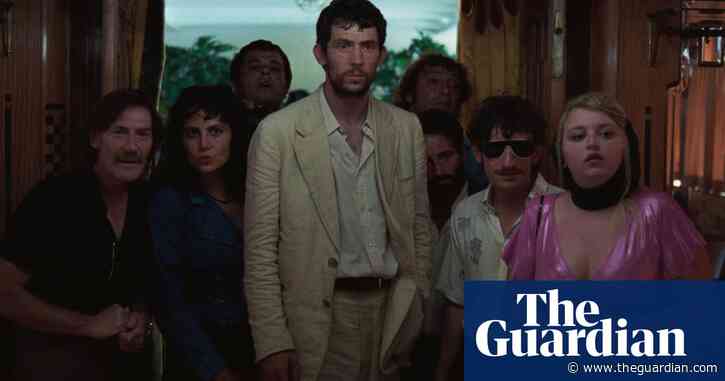 La Chimera looks like a crime caper about looters in 1980s Italy. But it’s about way more than that. The great director, loved by everyone from Scorsese to Gerwig, talks about the dark secrets of the heart – and her debt to beesAlice Rohrwacher could be the European arthouse made flesh, or its distilled essence, bottled and preserved for the ages. She’s quoting Italian poets one minute and German poets the next. She’s discussing nature, civilisation and the power of colle
La Chimera looks like a crime caper about looters in 1980s Italy. But it’s about way more than that. The great director, loved by everyone from Scorsese to Gerwig, talks about the dark secrets of the heart – and her debt to beesAlice Rohrwacher could be the European arthouse made flesh, or its distilled essence, bottled and preserved for the ages. She’s quoting Italian poets one minute and German poets the next. She’s discussing nature, civilisation and the power of colle -
Medievalist in North Wales, I: Castell Dolbadarn
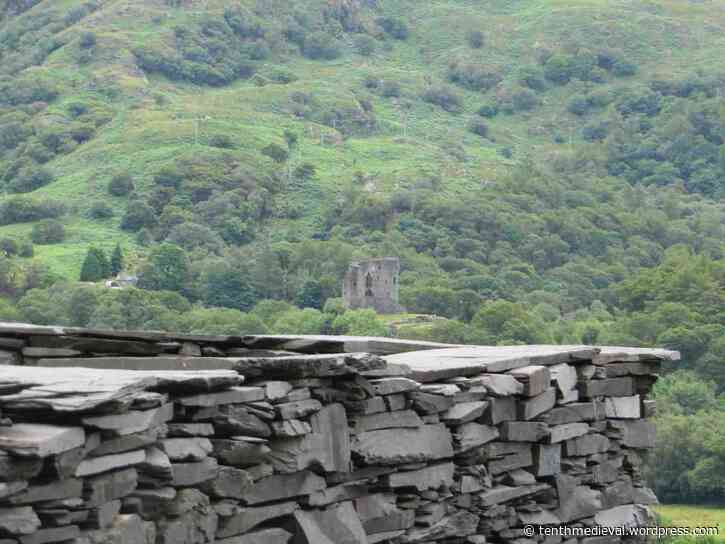 After such a huge post for last week, and so late, it seems wise to go for something lighter this week, so here are some pictures. In July 2021, right after the digital IMC was finished, my partner and I lit out for Wales. This was still on the declining edge of lockdown, so that we weren’t always sure what would be open, but enough seemed safe that we had quite an itinerary. This was, for once, not medievalist in intent – industrial heritage, if anything, was our plan – but yo
After such a huge post for last week, and so late, it seems wise to go for something lighter this week, so here are some pictures. In July 2021, right after the digital IMC was finished, my partner and I lit out for Wales. This was still on the declining edge of lockdown, so that we weren’t always sure what would be open, but enough seemed safe that we had quite an itinerary. This was, for once, not medievalist in intent – industrial heritage, if anything, was our plan – but yo -
IMC through a screen: the International Medieval Congress for 2021
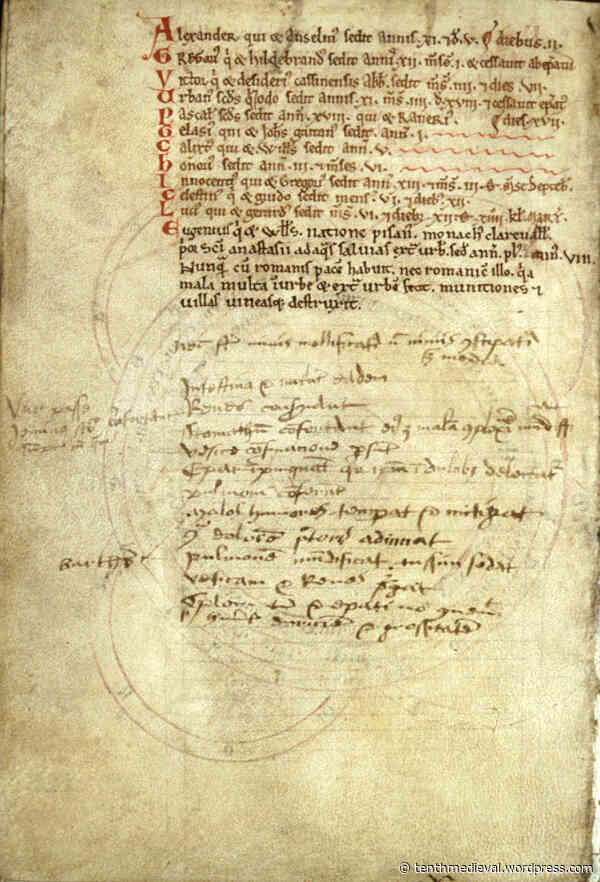 The late post this Bank Holiday weekend is partly because of various stuff involving builders and friends that has kept me from a keyboard. But, it is also, I admit, because when I looked at where I was in my backlog I realised it was up to the International Medieval Congress of July 2021, and then my brain rapidly grabbed at anything else that would be easier to do for a while. And I asked myself as usual, what is the point in reporting on conferences from years ago? But on reviewing my notes q
The late post this Bank Holiday weekend is partly because of various stuff involving builders and friends that has kept me from a keyboard. But, it is also, I admit, because when I looked at where I was in my backlog I realised it was up to the International Medieval Congress of July 2021, and then my brain rapidly grabbed at anything else that would be easier to do for a while. And I asked myself as usual, what is the point in reporting on conferences from years ago? But on reviewing my notes q -
Remains of horses buried 2,000 years ago found in central France
via theguardian.com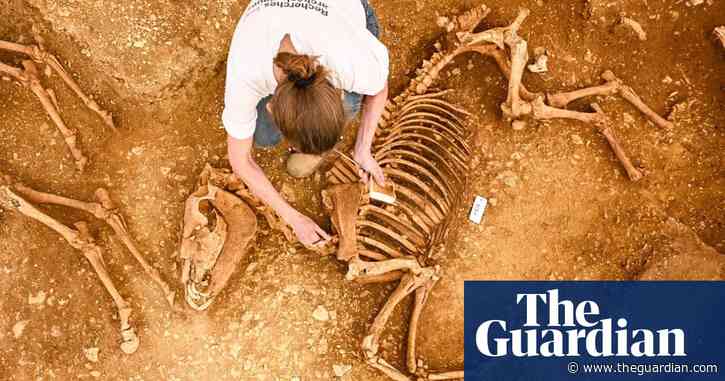 Archaeologists trying to determine whether animals were killed in battle or buried as part of a ritualFrench archaeologists have uncovered nine large graves containing the remains of horses from up to 2,000 years ago, in a find described as “extraordinary”.The 28 stallions, all around six years old, had been buried shortly after they died, each placed in pits on their right side with their head facing south. Nearby a grave contained the remains of two dogs, heads facing west. Continu
Archaeologists trying to determine whether animals were killed in battle or buried as part of a ritualFrench archaeologists have uncovered nine large graves containing the remains of horses from up to 2,000 years ago, in a find described as “extraordinary”.The 28 stallions, all around six years old, had been buried shortly after they died, each placed in pits on their right side with their head facing south. Nearby a grave contained the remains of two dogs, heads facing west. Continu -
Drawings depicting gladiators among latest discoveries at Pompeii
via theguardian.com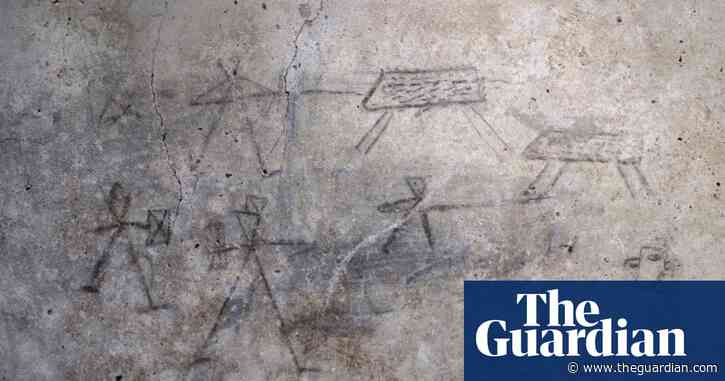 Charcoal graffiti believed to have been sketched by children uncovered at ancient Roman cityDrawings of gladiators believed to have been made by children inspired by watching battles at Pompeii’s amphitheatre are among the latest discoveries in the ruins of the ancient Roman city.The charcoal drawings were found during excavations at I’Insula dei Casti Amanti, a cluster of homes in Pompeii’s archaeological park that opened to the public for the first time on Tuesday. Continue r
Charcoal graffiti believed to have been sketched by children uncovered at ancient Roman cityDrawings of gladiators believed to have been made by children inspired by watching battles at Pompeii’s amphitheatre are among the latest discoveries in the ruins of the ancient Roman city.The charcoal drawings were found during excavations at I’Insula dei Casti Amanti, a cluster of homes in Pompeii’s archaeological park that opened to the public for the first time on Tuesday. Continue r -
Hobbyist archaeologists identify thousands of ancient sites in England
via theguardian.com Exclusive: Bronze age remains and Roman roads among 12,802 sites discovered using latest technologyBronze age burial mounds, Roman roads and deserted medieval villages are among almost 13,000 previously-unknown ancient sites and monuments that have been discovered by members of the public in recent months, it will be announced this week.Truck drivers and doctors are among more than 1,000 people who participated in Deep Time, a “citizen science project” which has harnessed the power o
Exclusive: Bronze age remains and Roman roads among 12,802 sites discovered using latest technologyBronze age burial mounds, Roman roads and deserted medieval villages are among almost 13,000 previously-unknown ancient sites and monuments that have been discovered by members of the public in recent months, it will be announced this week.Truck drivers and doctors are among more than 1,000 people who participated in Deep Time, a “citizen science project” which has harnessed the power o -
‘Moai designs are getting lost’: extreme weather chips away at Easter Island statues
via theguardian.com Experts call for conservation action as the features on Rapa Nui’s famous monoliths are eroded by fire and rainThe Ahu Tahai moai, on the east side of Rapa Nui, also known as Easter Island, is an impressive 4.5 metres high. Carved from a soft volcanic rock, the statue looks out solemnly over the island, with its back to the bay.The Tahai (“where the sun sets”) and the island’s other thousand or so moai were erected roughly between 1100 and 1700 as a representation of Rapa
Experts call for conservation action as the features on Rapa Nui’s famous monoliths are eroded by fire and rainThe Ahu Tahai moai, on the east side of Rapa Nui, also known as Easter Island, is an impressive 4.5 metres high. Carved from a soft volcanic rock, the statue looks out solemnly over the island, with its back to the bay.The Tahai (“where the sun sets”) and the island’s other thousand or so moai were erected roughly between 1100 and 1700 as a representation of Rapa -
Fragments of Mercian Memorial
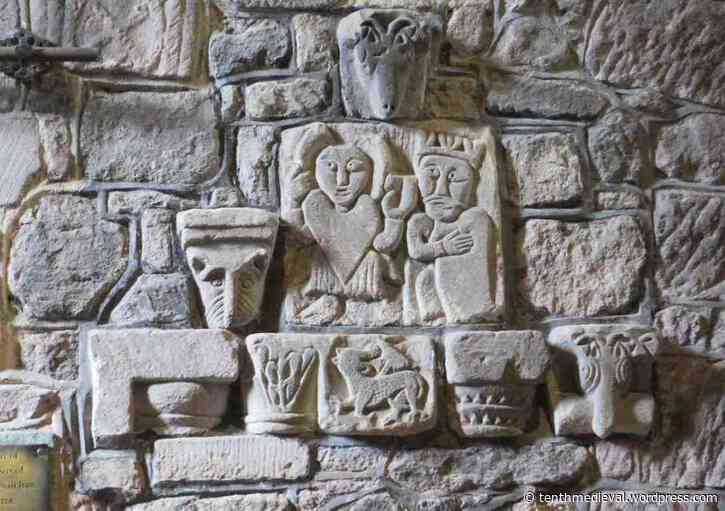 I’m travelling today for family reasons, so have only time for something short and hopefully sweet. At the very end of May 2021, for reasons I no longer remember, my partner and I were travelling through Derbyshire and there was a sign to a historic church. One of my great good fortunes in life is having someone with me in it who when asked, "shall we have a look?", will say yes if it’s even halfway sensible. So we did, and it turned out to be St Mary’s Wirksworth.
I’m travelling today for family reasons, so have only time for something short and hopefully sweet. At the very end of May 2021, for reasons I no longer remember, my partner and I were travelling through Derbyshire and there was a sign to a historic church. One of my great good fortunes in life is having someone with me in it who when asked, "shall we have a look?", will say yes if it’s even halfway sensible. So we did, and it turned out to be St Mary’s Wirksworth.
St Mary&rsqu -
Scientists find buried branch of the Nile that may have carried pyramids’ stones
via theguardian.com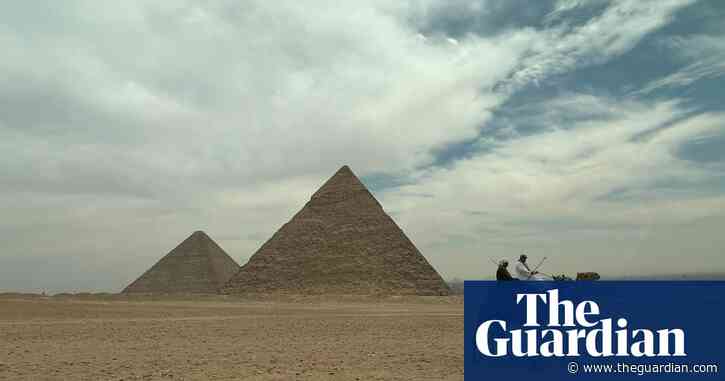 Discovery of the branch, which ran alongside 31 pyramids, could solve mystery of blocks’ transportationScientists have discovered a long-buried branch of the Nile River that once flowed alongside more than 30 pyramids in Egypt, potentially solving the mystery of how ancient Egyptians transported the massive stone blocks to build the monuments.The 40-mile-long (64km) river branch, which ran by the Giza pyramid complex among other wonders, was hidden under desert and farmland for millennia,
Discovery of the branch, which ran alongside 31 pyramids, could solve mystery of blocks’ transportationScientists have discovered a long-buried branch of the Nile River that once flowed alongside more than 30 pyramids in Egypt, potentially solving the mystery of how ancient Egyptians transported the massive stone blocks to build the monuments.The 40-mile-long (64km) river branch, which ran by the Giza pyramid complex among other wonders, was hidden under desert and farmland for millennia, -
Bad numbers by Karl-Ferdinand Werner
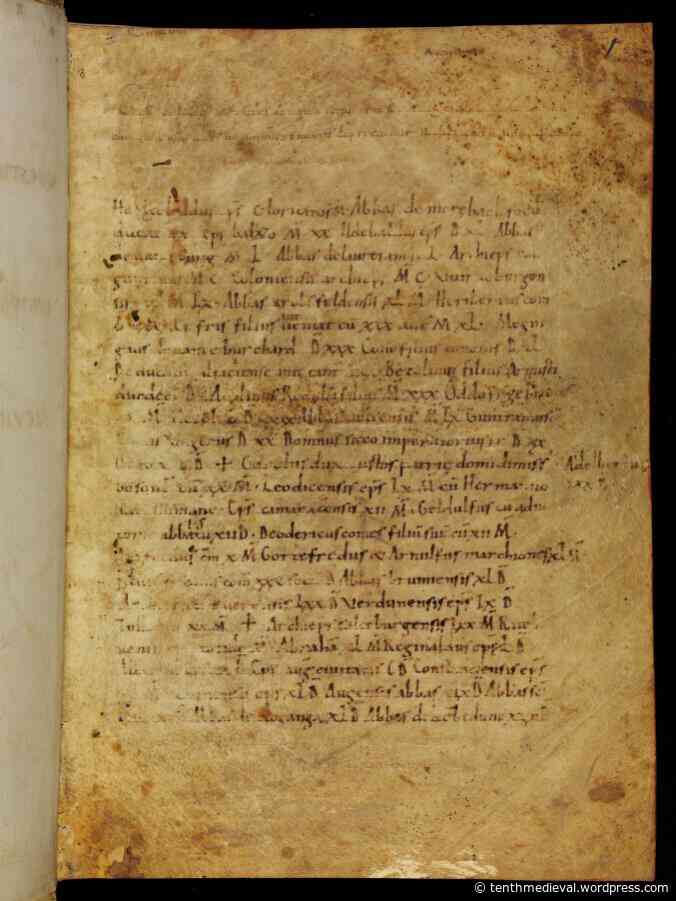 I’m not sure how true this is in this third decade of the twenty-first century, but if like me you were first learning about the Carolingian empire of Charlemagne and sons in the last decade of the previous one, you probably didn’t get far before you encountered the name Karl-Ferdinand Werner (1924-2008). Some of the really major studies of how that empire worked, administratively, came from his pen or typewriter, and he always seemed to be capable of understanding that the administr
I’m not sure how true this is in this third decade of the twenty-first century, but if like me you were first learning about the Carolingian empire of Charlemagne and sons in the last decade of the previous one, you probably didn’t get far before you encountered the name Karl-Ferdinand Werner (1924-2008). Some of the really major studies of how that empire worked, administratively, came from his pen or typewriter, and he always seemed to be capable of understanding that the administr -
Neolithic site in Orkney to be reburied after 20 years of excavation
via theguardian.com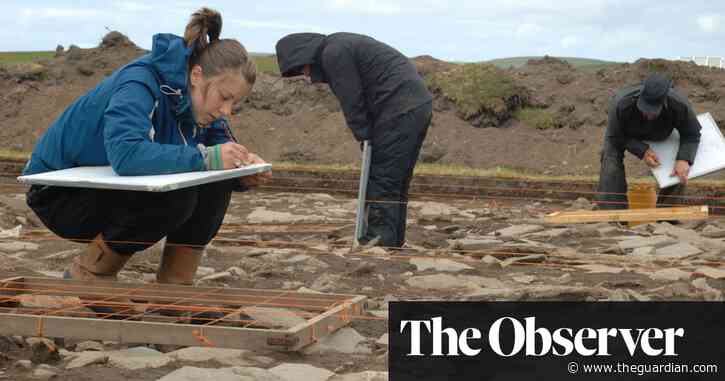 After one final dig, Ness of Brodgar is to be covered up to protect it for future generationsIn a few weeks, archaeologists will gather at the Ness of Brodgar in Orkney and for the next two months excavate at one of Europe’s greatest prehistoric sites.For the last 20 summers, scientists and volunteers have dug here, revealing wonders that include 5,000-year-old remains of temples, hearths, a ceramic figurine, and elegant pottery. Continue reading...
After one final dig, Ness of Brodgar is to be covered up to protect it for future generationsIn a few weeks, archaeologists will gather at the Ness of Brodgar in Orkney and for the next two months excavate at one of Europe’s greatest prehistoric sites.For the last 20 summers, scientists and volunteers have dug here, revealing wonders that include 5,000-year-old remains of temples, hearths, a ceramic figurine, and elegant pottery. Continue reading... -
Teacher finds stone with ancient ogham writing from Ireland in Coventry garden
via theguardian.com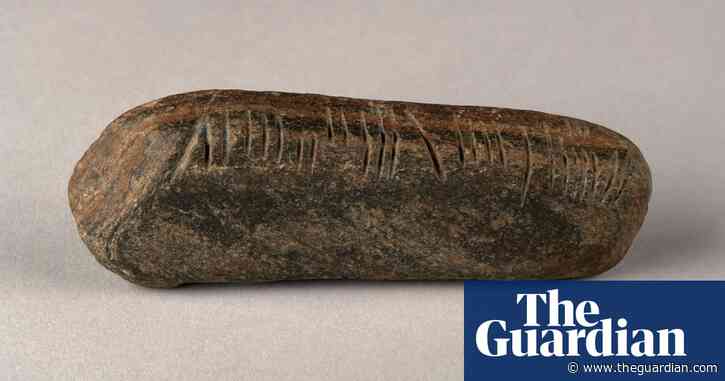 Exclusive: Sandstone rock featuring language markings created 1,600 years ago to go on display at museumA geography teacher was tidying his overgrown garden at his home in Coventry when he stumbled across a rock with mysterious incisions. Intrigued, he sent photographs to a local archaeologist and was taken aback to learn that the markings were created more than 1,600 years ago and that the artefact was worthy of a museum.The rectangular sandstone rock that Graham Senior had discovered was inscr
Exclusive: Sandstone rock featuring language markings created 1,600 years ago to go on display at museumA geography teacher was tidying his overgrown garden at his home in Coventry when he stumbled across a rock with mysterious incisions. Intrigued, he sent photographs to a local archaeologist and was taken aback to learn that the markings were created more than 1,600 years ago and that the artefact was worthy of a museum.The rectangular sandstone rock that Graham Senior had discovered was inscr -
Call for port extension to be halted as genocide remains are found on Namibia’s Shark Island
via theguardian.com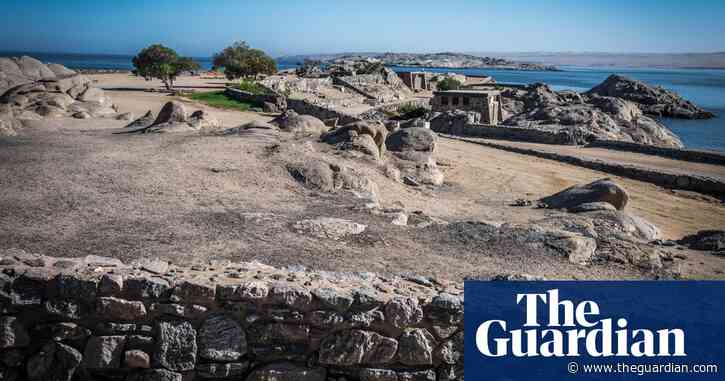 Researchers say more bodies of Herero and Nama people from early 20th century concentration camp could be in waters around portThe Namibian authorities are being urged to halt plans to extend a port on the Shark Island peninsula after the discovery of unmarked graves and artefacts relating to the Herero and Nama genocide.Forensic Architecture, a non-profit research agency, said it had located sites of executions, forced labour, imprisonment and sexual violence that occurred when the island was u
Researchers say more bodies of Herero and Nama people from early 20th century concentration camp could be in waters around portThe Namibian authorities are being urged to halt plans to extend a port on the Shark Island peninsula after the discovery of unmarked graves and artefacts relating to the Herero and Nama genocide.Forensic Architecture, a non-profit research agency, said it had located sites of executions, forced labour, imprisonment and sexual violence that occurred when the island was u -
What could the Roman dodecahedron have been used for?
via theguardian.com The long-running series in which readers answer other readers’ questions on subjects ranging from trivial flights of fancy to profound scientific and philosophical conceptsA 12-sided, 1,700-year-old object with no known purpose was found in Lincolnshire last summer and has just gone on display at Lincoln Museum. What could it have been used for? Paul Elliott, by emailPost your answers (and new questions) below or send them to [email protected]. A selection will be published next Sunday. C
The long-running series in which readers answer other readers’ questions on subjects ranging from trivial flights of fancy to profound scientific and philosophical conceptsA 12-sided, 1,700-year-old object with no known purpose was found in Lincolnshire last summer and has just gone on display at Lincoln Museum. What could it have been used for? Paul Elliott, by emailPost your answers (and new questions) below or send them to [email protected]. A selection will be published next Sunday. C -
Not what the textbooks usually mean by ‘manuscript illustration’
 Thankyou all those who have encouraged me to keep going with the blog! Plans remain afoot, but for now you can certainly have this little gem (not a lettuce) which apparently I stashed for future writing up in May 2021. It speaks to some of the blog’s oldest themes, to wit protochronism, micro-histories in administrative documents and, not least, medieval sex, and I owe it to the sharp observation of Rebecca Darley, who had she known she was going to be doing the blogging thing herself aft
Thankyou all those who have encouraged me to keep going with the blog! Plans remain afoot, but for now you can certainly have this little gem (not a lettuce) which apparently I stashed for future writing up in May 2021. It speaks to some of the blog’s oldest themes, to wit protochronism, micro-histories in administrative documents and, not least, medieval sex, and I owe it to the sharp observation of Rebecca Darley, who had she known she was going to be doing the blogging thing herself aft -
Is this the answer to the Roman dodecahedron puzzle that has archaeologists stumped? | Letter
via theguardian.com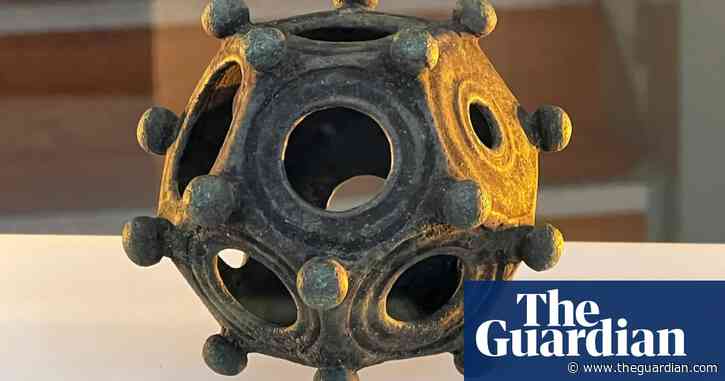 Guardian readers speculate on the purpose of a mysterious object unearthed at Norton Disney, near LincolnI wonder if the object (Mysterious Roman dodecahedron to go on display in Lincoln, 29 April) could be some kind of puzzle (quite apart from being a puzzle to archaeologists). Unless some Roman puzzle book survived, it seems unlikely that a puzzle object would crop up in Roman literature. It is small enough to be held in the hand, and possibly the puzzle was to wrap a string around each protub
Guardian readers speculate on the purpose of a mysterious object unearthed at Norton Disney, near LincolnI wonder if the object (Mysterious Roman dodecahedron to go on display in Lincoln, 29 April) could be some kind of puzzle (quite apart from being a puzzle to archaeologists). Unless some Roman puzzle book survived, it seems unlikely that a puzzle object would crop up in Roman literature. It is small enough to be held in the hand, and possibly the puzzle was to wrap a string around each protub -
A villa unveiled
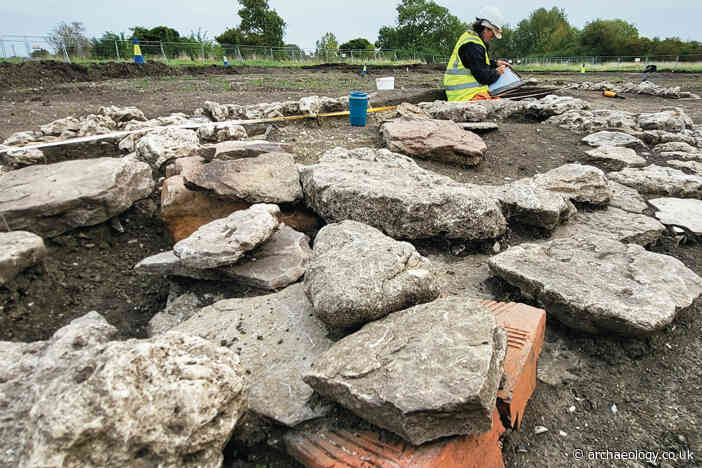 Uncovering luxury living and ‘ritual activity’ in Roman OxfordshireArchaeological work in rural Oxfordshire has uncovered the remains of a winged corridor villa that was occupied for much of the Roman period. Carly Hilts spoke to Louis Stafford to learn how the story of this long-lived, high-status residence is evolving as investigations continue.The remains of a Roman villa are being excavated on the outskirts of Grove, near Wantage in Oxfordshire. Although most of its buildings ap
Uncovering luxury living and ‘ritual activity’ in Roman OxfordshireArchaeological work in rural Oxfordshire has uncovered the remains of a winged corridor villa that was occupied for much of the Roman period. Carly Hilts spoke to Louis Stafford to learn how the story of this long-lived, high-status residence is evolving as investigations continue.The remains of a Roman villa are being excavated on the outskirts of Grove, near Wantage in Oxfordshire. Although most of its buildings ap -
Alex Hooper obituary
via theguardian.com My husband, Alex Hooper, who has died aged 82 after a long illness, had an extraordinarily varied career, including as an archaeologist, film-maker, merchant seaman, teacher and gallery curator.In the late 1960s, while doing an MA in film studies at the Slade School of Fine Art, Alex became close friends with Peter Gibson of Brett Marvin and the Thunderbolts, and the pair made a documentary about the blues musician John Mayall, The Turning Point (1969). Through going on tour with Mayall, and mak
My husband, Alex Hooper, who has died aged 82 after a long illness, had an extraordinarily varied career, including as an archaeologist, film-maker, merchant seaman, teacher and gallery curator.In the late 1960s, while doing an MA in film studies at the Slade School of Fine Art, Alex became close friends with Peter Gibson of Brett Marvin and the Thunderbolts, and the pair made a documentary about the blues musician John Mayall, The Turning Point (1969). Through going on tour with Mayall, and mak -
Leprosy passed between medieval squirrels and humans, study suggests
via theguardian.com Genetic analysis of Winchester samples shows similar strains of disease and supports theory that fur trade played role in spreadLeprosy passed between humans and red squirrels in medieval England, research suggests, supporting the theory that the fur trade could have played a role in the spread of the disease.Leprosy is one of the oldest infectious diseases recorded in humans and is typically caused by the bacterium Mycobacterium leprae. Continue reading...
Genetic analysis of Winchester samples shows similar strains of disease and supports theory that fur trade played role in spreadLeprosy passed between humans and red squirrels in medieval England, research suggests, supporting the theory that the fur trade could have played a role in the spread of the disease.Leprosy is one of the oldest infectious diseases recorded in humans and is typically caused by the bacterium Mycobacterium leprae. Continue reading... -
‘Second renaissance’: tech uncovers ancient scroll secrets of Plato and co
via theguardian.com Researchers and Silicon Valley are using tools powered by AI to read what had long been thought unreadableMore than 2,000 years after Plato died, the towering figure of classical antiquity and founder of the Academy, regarded by many as the first university in the west, can still make front-page news.Researchers this week claimed to have found the final resting place of the Greek philosopher, a patch in the garden of his Athens Academy, after scanning an ancient papyrus scroll recovered from the
Researchers and Silicon Valley are using tools powered by AI to read what had long been thought unreadableMore than 2,000 years after Plato died, the towering figure of classical antiquity and founder of the Academy, regarded by many as the first university in the west, can still make front-page news.Researchers this week claimed to have found the final resting place of the Greek philosopher, a patch in the garden of his Athens Academy, after scanning an ancient papyrus scroll recovered from the -
Excavating the CA Archives – Wiltshire II
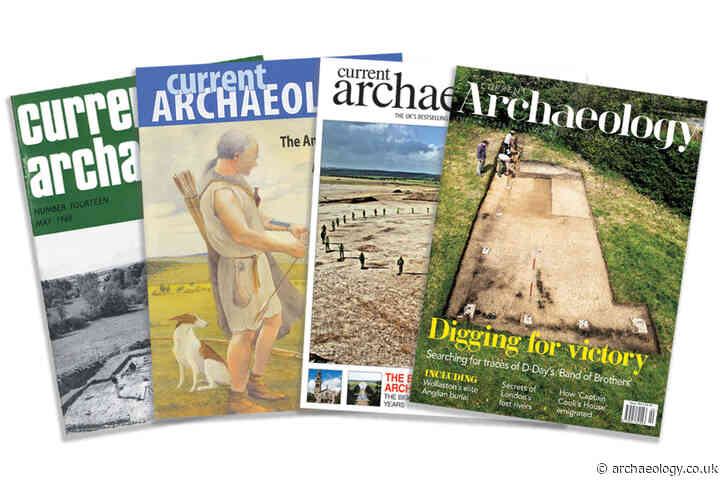 Excavating around Salisbury PlainLast month I began a tour around the final county of the UK that I had yet to visit in these pages: Wiltshire. I began in the north and headed south as far as the Vale of Pewsey. This month I will continue into what is popularly seen as the most fertile of all archaeological hunting grounds, the county’s central belt around Salisbury Plain. I will devote future columns specifically to Stonehenge and Avebury, so we will pass through these on this occasion i
Excavating around Salisbury PlainLast month I began a tour around the final county of the UK that I had yet to visit in these pages: Wiltshire. I began in the north and headed south as far as the Vale of Pewsey. This month I will continue into what is popularly seen as the most fertile of all archaeological hunting grounds, the county’s central belt around Salisbury Plain. I will devote future columns specifically to Stonehenge and Avebury, so we will pass through these on this occasion i -
Solar storms, ice cores and nuns’ teeth: the new science of history – podcast
via theguardian.com Advances in fields such as spectrometry and gene sequencing are unleashing torrents of new data about the ancient world – and could offer answers to questions we never even knew to ask. By Jacob Mikanowski Continue reading...
Advances in fields such as spectrometry and gene sequencing are unleashing torrents of new data about the ancient world – and could offer answers to questions we never even knew to ask. By Jacob Mikanowski Continue reading... -
Current Archaeology 411– ON SALE NOW
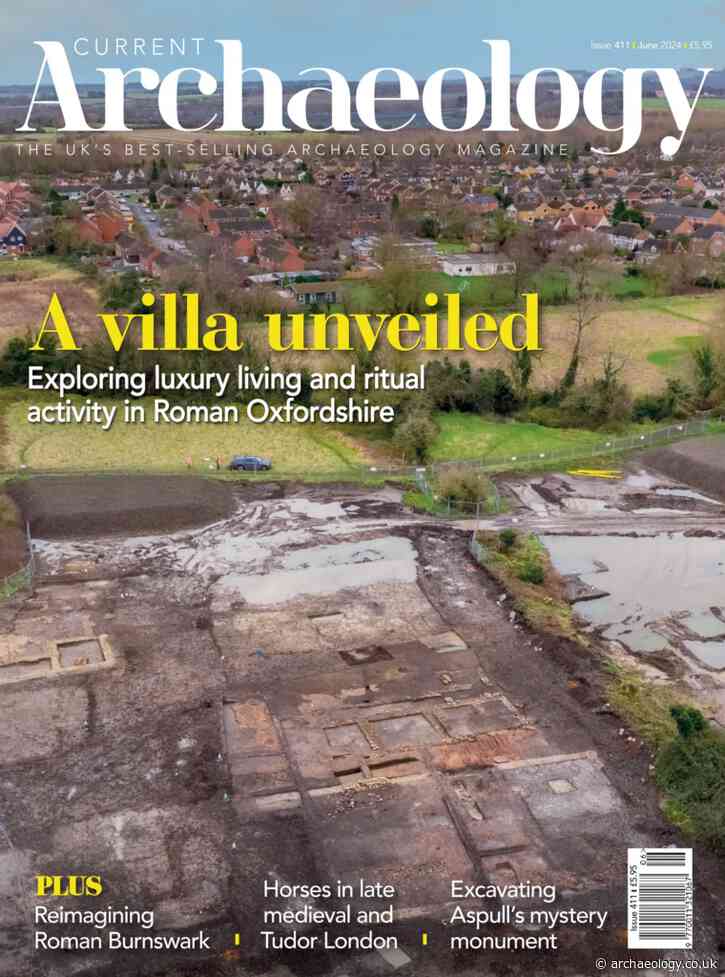 This month’s cover feature takes us into rural Oxfordshire, where archaeological investigations ahead of the construction of a housing estate have uncovered the remains of a previously unknown Roman villa. The site’s story is still developing, but finds already paint a picture of an elegantly appointed residence, as well as activities ranging from the agricultural to the industrial – and hints of some rather more enigmatic practices.The subject of our next feature is also unusu
This month’s cover feature takes us into rural Oxfordshire, where archaeological investigations ahead of the construction of a housing estate have uncovered the remains of a previously unknown Roman villa. The site’s story is still developing, but finds already paint a picture of an elegantly appointed residence, as well as activities ranging from the agricultural to the industrial – and hints of some rather more enigmatic practices.The subject of our next feature is also unusu -
Current Archaeology 411- ON SALE NOW
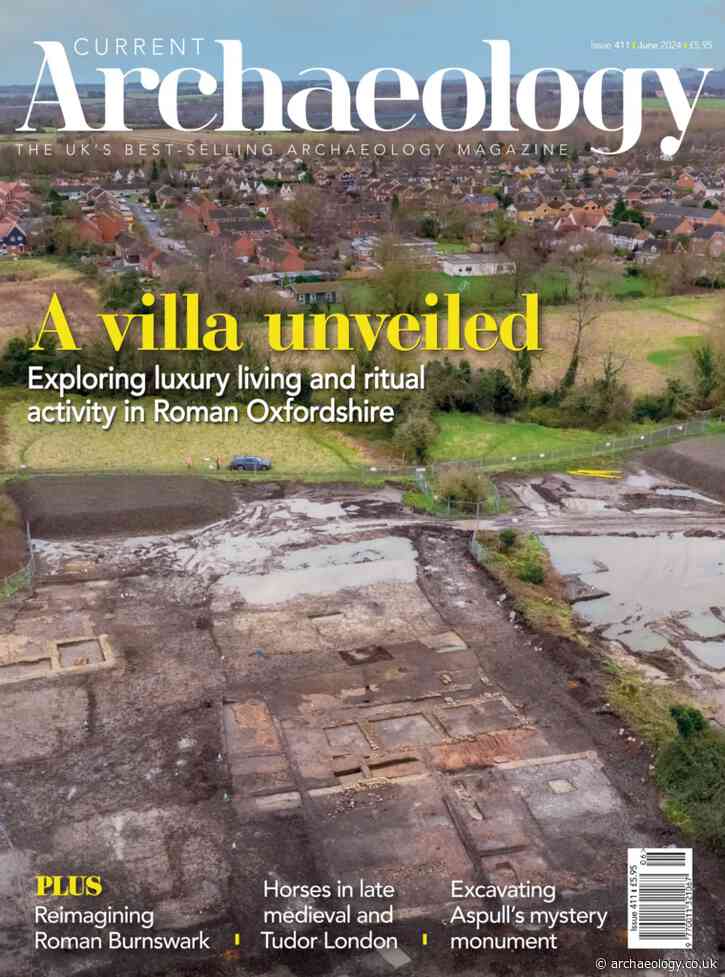 This month’s cover feature takes us into rural Oxfordshire, where archaeological investigations ahead of the construction of a housing estate have uncovered the remains of a previously unknown Roman villa. The site’s story is still developing, but finds already paint a picture of an elegantly appointed residence, as well as activities ranging from the agricultural to the industrial – and hints of some rather more enigmatic practices.The subject of our next feature is also unusu
This month’s cover feature takes us into rural Oxfordshire, where archaeological investigations ahead of the construction of a housing estate have uncovered the remains of a previously unknown Roman villa. The site’s story is still developing, but finds already paint a picture of an elegantly appointed residence, as well as activities ranging from the agricultural to the industrial – and hints of some rather more enigmatic practices.The subject of our next feature is also unusu -
When the milkman sparked a local panic | Brief letters
via theguardian.com Suspicious neighbours | Museum of the year | Ofsted | One word for the Tories | Roman dodecahedronArwa Mahdawi can be assured that over-suspicious neighbours are not restricted to New York (It’s not stranger danger you should be afraid of, it’s video doorbell derangement syndrome, 1 May). A local Facebook page went into meltdown about a man who was seen driving down the road in the early hours, stopping regularly and running up people’s drives, clearly looking for easy access.
Suspicious neighbours | Museum of the year | Ofsted | One word for the Tories | Roman dodecahedronArwa Mahdawi can be assured that over-suspicious neighbours are not restricted to New York (It’s not stranger danger you should be afraid of, it’s video doorbell derangement syndrome, 1 May). A local Facebook page went into meltdown about a man who was seen driving down the road in the early hours, stopping regularly and running up people’s drives, clearly looking for easy access. -
Dorset auction house withdraws Egyptian human skulls from sale
via theguardian.com MP says trade in remains is ‘gross violation of human dignity’, as skulls from Pitt Rivers collection removedAn auction house has withdrawn 18 ancient Egyptian human skulls from sale after an MP said selling them would perpetuate the atrocities of colonialism.Bell Ribeiro-Addy, the chair of the all-party parliamentary group on Afrikan reparations, believes the sale of human remains for any purposes should be outlawed, adding that the trade was “a gross violation of human dignit
MP says trade in remains is ‘gross violation of human dignity’, as skulls from Pitt Rivers collection removedAn auction house has withdrawn 18 ancient Egyptian human skulls from sale after an MP said selling them would perpetuate the atrocities of colonialism.Bell Ribeiro-Addy, the chair of the all-party parliamentary group on Afrikan reparations, believes the sale of human remains for any purposes should be outlawed, adding that the trade was “a gross violation of human dignit -
Mary Greenacre obituary
via theguardian.com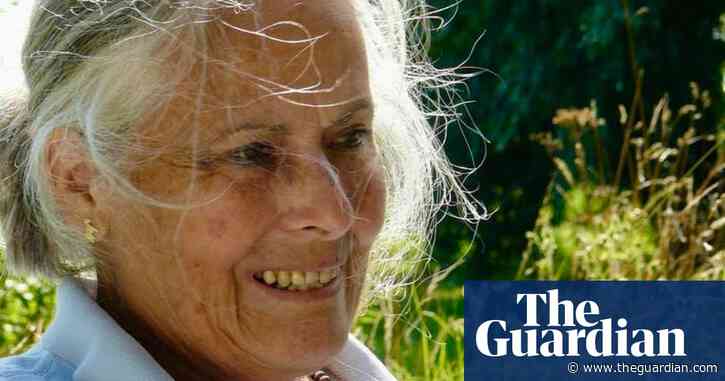 My friend Mary Greenacre, who has died aged 77, was an archaeological and museum conservator of distinction, possessing an innate empathy with fragile and precious objects.Mary specialised in ceramics, and came to understand prehistoric pottery, 18th-century terracotta sculpture and Delftware. She became conservator at the South West Area Museum Service in Bristol in 1969, where she met Francis Greenacre, curator of fine art at the City Art Gallery. They married within six months and became the
My friend Mary Greenacre, who has died aged 77, was an archaeological and museum conservator of distinction, possessing an innate empathy with fragile and precious objects.Mary specialised in ceramics, and came to understand prehistoric pottery, 18th-century terracotta sculpture and Delftware. She became conservator at the South West Area Museum Service in Bristol in 1969, where she met Francis Greenacre, curator of fine art at the City Art Gallery. They married within six months and became the -
Five skeletons found under Wolf’s Lair home of Hermann Göring in Poland
via theguardian.com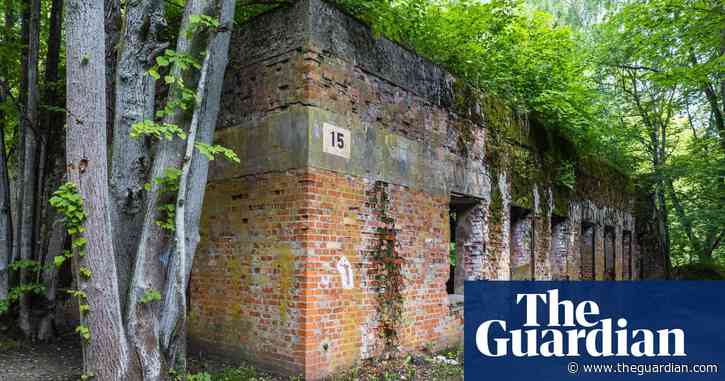 Amateur archaeologists discover remains missing hands and feet at former Nazi military headquartersAmateur archaeologists have unearthed five human skeletons missing their hands and feet under the former home of the Nazi war criminal Hermann Göring at Hitler’s Wolf’s Lair military headquarters in present-day Poland.The remains, believed to be that of a family, were discovered as part of a dig at the site near the north-eastern town of Kętrzyn, where Nazi leaders spent large
Amateur archaeologists discover remains missing hands and feet at former Nazi military headquartersAmateur archaeologists have unearthed five human skeletons missing their hands and feet under the former home of the Nazi war criminal Hermann Göring at Hitler’s Wolf’s Lair military headquarters in present-day Poland.The remains, believed to be that of a family, were discovered as part of a dig at the site near the north-eastern town of Kętrzyn, where Nazi leaders spent large -
Mysterious Roman dodecahedron to go on display in Lincoln
via theguardian.com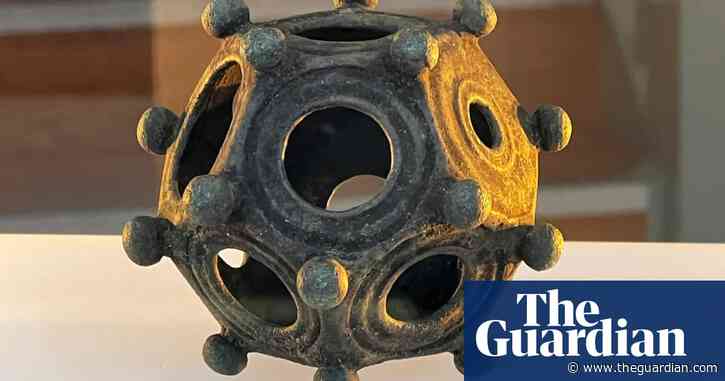 There are no known descriptions or drawings of object in Roman literature, making its purpose unclearThey are known as one of archaeology’s great enigmas – hollow 12-sided objects from the Roman era with no known purpose or use.Only 33 of these mysterious dodecahedrons have ever been found in Britain and now one, unearthed during an amateur archaeology dig after 1,700 years underground, is going on public display in Lincoln as part of a history festival. Continue reading...
There are no known descriptions or drawings of object in Roman literature, making its purpose unclearThey are known as one of archaeology’s great enigmas – hollow 12-sided objects from the Roman era with no known purpose or use.Only 33 of these mysterious dodecahedrons have ever been found in Britain and now one, unearthed during an amateur archaeology dig after 1,700 years underground, is going on public display in Lincoln as part of a history festival. Continue reading... -
Lost civilisations make good TV, but archaeology’s real stories hold far more wonder | Flint Dibble
via theguardian.com I took on a pseudoscientist because misinformation about history too often goes unchallengedIt’s important to start strong. That’s true of a lot of things in life, but doubly so when you’re an archaeologist starting off a conversation with Graham Hancock, the famed pseudoarchaeology author, in a venue such as the Joe Rogan Experience podcast.For the last decade, scholars and experts have dealt with misinformation and pseudoscience either by trying to ignore it in order not to a
I took on a pseudoscientist because misinformation about history too often goes unchallengedIt’s important to start strong. That’s true of a lot of things in life, but doubly so when you’re an archaeologist starting off a conversation with Graham Hancock, the famed pseudoarchaeology author, in a venue such as the Joe Rogan Experience podcast.For the last decade, scholars and experts have dealt with misinformation and pseudoscience either by trying to ignore it in order not to a
Follow @archaeology_uk1 on Twitter!

